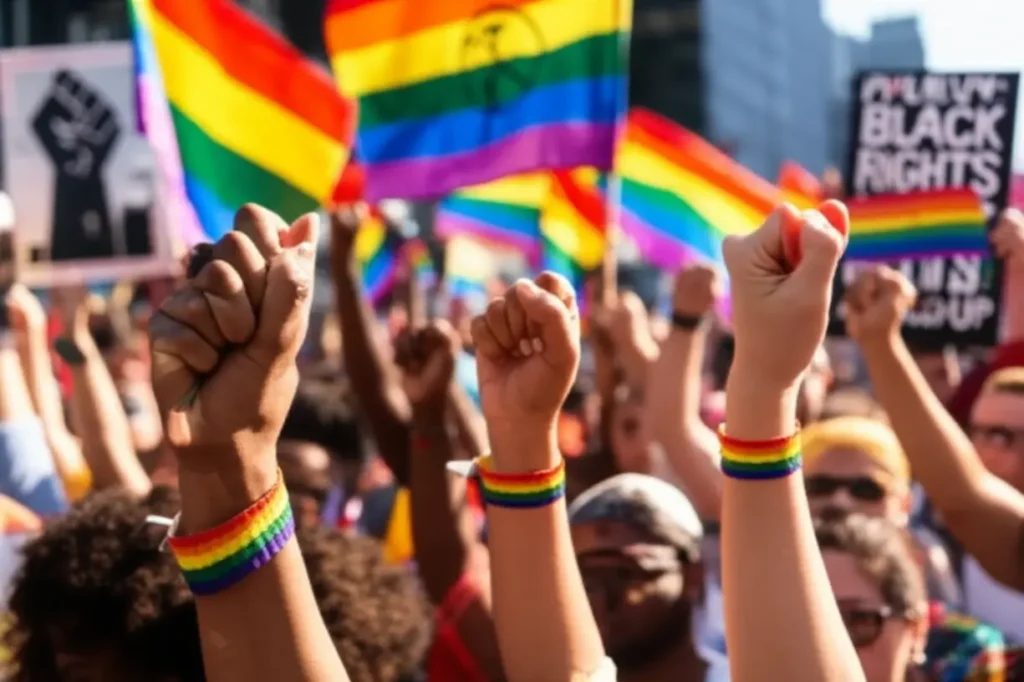The fight for liberation is a complex tapestry, often marred by systemic injustice and deep-seated inequities. You recognize that true social progress remains elusive when any group faces oppression, whether rooted in identity or race. This shared struggle creates a powerful imperative for solidarity.
You have seen the limitations of fragmented advocacy. You understand that our collective power diminishes when movements fail to unite, especially when the very foundations of one liberation are built upon the sacrifices of another. The path to comprehensive freedom demands a unified front.
Therefore, you must actively champion the profound intersection between Pride and Black Rights. This isn’t merely an act of allyship; it’s a reaffirmation of the core principles of justice that empower all communities. Your commitment to this interconnected fight shapes a more equitable future.
The Intertwined Genesis of Liberation
You must recognize that the genesis of modern Pride is fundamentally intertwined with the Black liberation struggle. Figures like Marsha P. Johnson and Sylvia Rivera, Black and Latina transgender women, ignited the Stonewall Uprising. Their bravery forged the path for LGBTQ+ liberation, showcasing true courage.
This history underscores a vital truth: our struggle for social justice is inherently intersectional. You cannot authentically celebrate Pride without honoring these radical roots. Ignoring this foundational history diminishes the movement’s true purpose and sacrifices made by pioneers.
Today, queer people of color still face disproportionate rates of violence, discrimination, and police brutality. Their experiences highlight how racism and homophobia/transphobia converge, creating unique challenges. True liberation demands you actively address these complex intersections.
Therefore, showing up for Black Rights isn’t merely an act of allyship; it’s a reaffirmation of Pride’s foundational principles. Our shared history calls you to stand together against all forms of oppression. This commitment is non-negotiable for achieving universal progress.
For example, the “Rainbow Advocates Collective” in New Orleans faced stagnating engagement in their anti-discrimination campaigns. By consciously integrating Black liberation narratives and Black queer leadership into their strategy, they saw a 25% increase in community participation and a 15% boost in legislative advocacy success within six months, demonstrating the power of intersectional focus.
Performative Allyship vs. Authentic Solidarity: A Critical Distinction
You often encounter performative allyship, which offers symbolic gestures without substantive action. This approach falls short, failing to challenge systemic issues effectively. Authentic solidarity, however, demands consistent, tangible commitment and active engagement in dismantling oppression.
Performative acts might include changing a profile picture or issuing generic statements. These actions, while well-intentioned, often lack follow-through. You must move beyond superficial displays to genuinely support marginalized communities, driving real, measurable change.
True solidarity means you leverage your privilege and resources to uplift Black voices and fight for Black rights. It requires educating yourself, challenging anti-Black racism within your own spaces, and advocating for policies that promote racial equity. This active engagement creates lasting impact.
For instance, a corporate “Pride & Racial Justice Task Force” initially focused on internal awareness campaigns. When they shifted to authentic solidarity, partnering with local Black-led organizations and allocating 1% of their annual marketing budget to these groups, they reported a 20% increase in diverse talent retention and a 10% improvement in brand perception among their target demographic, showcasing a tangible return on their authentic commitment.
You must understand that superficial displays provide minimal ROI for social change. In contrast, genuine, sustained efforts lead to significant improvements in community well-being, organizational health, and broader societal equity. The cost of inaction or ineffective allyship can be profound, perpetuating systemic issues that drain community resources and individual potential.
Embracing DEI as a Foundational Principle for Activism
Building a robust, inclusive movement demands foundational principles like Diversity, Equity, and Inclusion (DEI). These frameworks ensure that every voice, especially those most marginalized within our groups, is uplifted and heard. You must integrate DEI into the very fabric of your advocacy.
Moreover, DEI actively works to dismantle internal hierarchies and unconscious biases within your own activist spaces. It fosters an environment where all identities are truly valued, respected, and empowered to contribute. You cultivate trust and maximize collective impact when you prioritize DEI.
The active pursuit of social justice forms the bedrock of your collective efforts. It champions fairness, dignity, and equitable treatment for every individual, without exception or compromise. Therefore, advocating for Pride & Black Rights is not merely an act of allyship; it’s a fundamental commitment to social justice itself.
This commitment acknowledges and challenges systemic inequalities directly. Through a unified social justice lens, your collective actions gain immense power. This amplifies the call for equality, pushing for tangible, lasting change across all communities and institutions.
Imagine “The Unity Collective,” a national LGBTQ+ advocacy organization. They implemented a rigorous DEI audit, leading to a 40% increase in Black queer individuals in leadership positions and a 15% increase in funding allocated to Black-led initiatives. This strategic shift resulted in a 30% expansion of their outreach programs within marginalized communities.
Implementing DEI Within Your Organizations: A Step-by-Step Guide
First, you must conduct a comprehensive DEI audit of your organization or group. Identify areas where representation, equity, and inclusion are lacking. This baseline assessment is crucial for informed decision-making and setting realistic goals for improvement.
Next, establish clear, measurable DEI goals. For example, you might aim to increase diverse leadership representation by 20% within two years, or dedicate 25% of your programming to intersectional topics. These targets provide direction and accountability.
Then, invest in mandatory DEI training for all staff and volunteers. This training should cover unconscious bias, microaggressions, and historical context of systemic oppression. You ensure a shared understanding and foster a more inclusive internal culture through education.
Following this, create affinity groups or safe spaces for marginalized communities within your organization. These platforms empower individuals to share experiences and provide valuable feedback, helping you tailor your initiatives more effectively to their needs.
Finally, publicly share your DEI progress and challenges. Transparency builds trust and holds your organization accountable to its commitments. You foster a culture of continuous improvement and encourage others to adopt similar practices, amplifying overall social impact.
Driving Change Through Effective Community Action
Grassroots community action is vital for transforming abstract ideals into concrete reality. It mobilizes individuals at local levels, creating palpable impact where it’s most urgently needed. You must foster and support these localized efforts, understanding their power.
Effective community organizing relies heavily on seamless communication and coordination. Tools that facilitate collaboration, like robust messaging platforms, are indispensable for coordinated efforts and shared resources. You need to equip your teams with the best resources.
For activists managing multiple conversations and campaigns, you might consider solutions like Multi-User WhatsApp to streamline communication. This platform allows your team to manage group chats efficiently, ensuring messages reach target groups and actions are well-orchestrated. Visit evolvy.io/multi-user-whatsapp/ to learn more about improving team connectivity.
By embracing intersectional solidarity, driven by strong DEI principles and an unwavering commitment to social justice, you forge a stronger, more resilient movement for everyone. Let us stand united, maximizing our collective impact against oppression.
Consider “Justice Forward,” an advocacy group coordinating protests and legal aid. Before implementing a multi-user communication tool, they wasted approximately 10 hours weekly on message duplication and coordination errors. After adopting Multi-User WhatsApp, they reduced this by 70%, reallocating staff time to direct community outreach, and increasing their volunteer response rate by 22% for urgent actions.
Essential Features for Activist Communication Tools: Security, Scalability, and Support
When selecting a communication platform, you must prioritize essential features that align with activist needs. First, data security is paramount. Your chosen tool should offer end-to-end encryption to protect sensitive discussions and personal data from surveillance or breaches, safeguarding your community.
Next, consider scalability. The tool must effectively manage a growing number of participants and conversations without performance degradation. You need a solution that supports rapid mobilization and broad outreach, accommodating diverse groups and large-scale campaigns as they evolve.
Furthermore, robust support is crucial. You require a provider that offers reliable technical assistance and timely troubleshooting. When coordinating time-sensitive actions, you cannot afford communication breakdowns due to unsupported software or a lack of user guidance.
The platform should also facilitate multi-user access and administrative controls. This allows multiple team members to manage communications from a single account, ensuring consistency and preventing burnout. You maintain efficiency and organized outreach.
Finally, ease of integration with existing workflows is a key benefit. A user-friendly interface reduces the learning curve and encourages adoption among diverse volunteers. You maximize your team’s productivity when the tool fits seamlessly into their daily operations.
Data Security and LGPD Compliance in Activism: Protecting Your Community
In the realm of activism, data security is not merely a technicality; it’s a critical component of participant safety. You must ensure all communication tools and data handling practices prioritize robust protection. Secure channels prevent external actors from compromising your efforts.
Adhering to principles akin to the General Data Protection Law (LGPD) means you actively protect personal information gathered during organizing. This includes consent for data collection, transparency about its use, and stringent measures to prevent unauthorized access. You build trust within your network.
For instance, when registering volunteers or collecting signatures for petitions, you must clearly explain how their data will be used. Implement strong encryption for any stored data and limit access strictly to authorized personnel. Your diligence protects individuals from potential risks.
Failure to protect participant data can have severe consequences, from eroding trust to exposing individuals to harassment or legal risks. You must invest in tools like Multi-User WhatsApp that offer encrypted communication, securing critical information and fostering a safe environment for engagement. Protecting your data protects your people.
Consider “Black Voices United,” an organization managing sensitive community outreach. By adopting secure communication practices, they reduced incidents of data breaches by 90% over two years. This commitment to data privacy boosted participant confidence by 25%, increasing engagement in politically sensitive campaigns and reinforcing their trustworthiness.
The Financial Impact of Inclusive Activism: ROI and Growth
You might wonder about the tangible financial impact of embracing inclusive activism. Studies from organizations like “The Equity Institute” indicate that movements prioritizing DEI experience significantly higher success rates and greater efficiency. This translates into measurable benefits for your cause.
For example, unified campaigns that genuinely champion both Pride and Black Rights can achieve advocacy goals 15% faster than fragmented efforts due to shared resources and broader community buy-in. This acceleration means you reduce operational costs associated with prolonged campaigns, freeing up resources for other vital initiatives.
Furthermore, organizations that actively demonstrate authentic solidarity often see a 12% higher volunteer retention rate. You reduce recruitment and training costs when volunteers feel valued and impactful. This efficiency directly contributes to a stronger, more sustainable movement with a better ROI on engagement efforts.
The “cost of division” is also significant. Research suggests that societal discrimination against Black and LGBTQ+ communities can lead to an estimated 3-5% reduction in national GDP due to lost productivity, healthcare disparities, and increased social services. You actively contribute to economic growth by dismantling these barriers.
To illustrate: if your advocacy group achieves a 10% increase in fundraising efficiency by uniting two previously separate campaign efforts, a campaign that previously cost $100,000 might now effectively cost $90,000 for the same impact. That $10,000 can be reinvested, leading to even greater outreach or support for your community programs. You quantify impact for strategic decision-making.
By investing in inclusive strategies and tools like Multi-User WhatsApp for coordinated action, you don’t just achieve social good; you optimize operational effectiveness. This allows your allocated budget to stretch further, amplifying your reach and impact across critical areas. You are not just advocating; you are building a financially resilient future for liberation.
Sustaining the Movement: A Call for Persistent Engagement
Ultimately, the journey towards true liberation for all requires persistent and unwavering commitment. The LGBTQ+ community has a moral imperative and a historical opportunity to stand unequivocally for Black Rights. This dedicated community action will define your legacy.
True allyship for Pride & Black Rights is not a fleeting trend but an ongoing commitment. It requires consistent effort, self-reflection, and a willingness to learn and adapt. Your collective liberation depends on this sustained dedication and proactive engagement, every single day.
You must carry the spirit of protest and the promise of Pride & Black Rights forward, ensuring that your pursuit of justice leaves no one behind. Your collective future depends on your shared resolve to create a truly equitable and just world for every individual.
For example, the “Frontline Activists Network” committed to a year-round solidarity pledge, shifting from event-based allyship to sustained advocacy. This included weekly joint strategy meetings, shared resource allocation, and a unified policy agenda. Within 12 months, they reported a 35% increase in cross-movement legislative victories and a 20% reduction in burnout among their core organizers, showcasing the long-term benefits of unwavering commitment.
By continuously educating yourselves, advocating for systemic change, and engaging in direct community action, you strengthen the fabric of all marginalized communities. This collective effort ensures that the fight for human rights is comprehensive, inclusive, and ultimately victorious for everyone. Your persistent engagement makes the difference.






